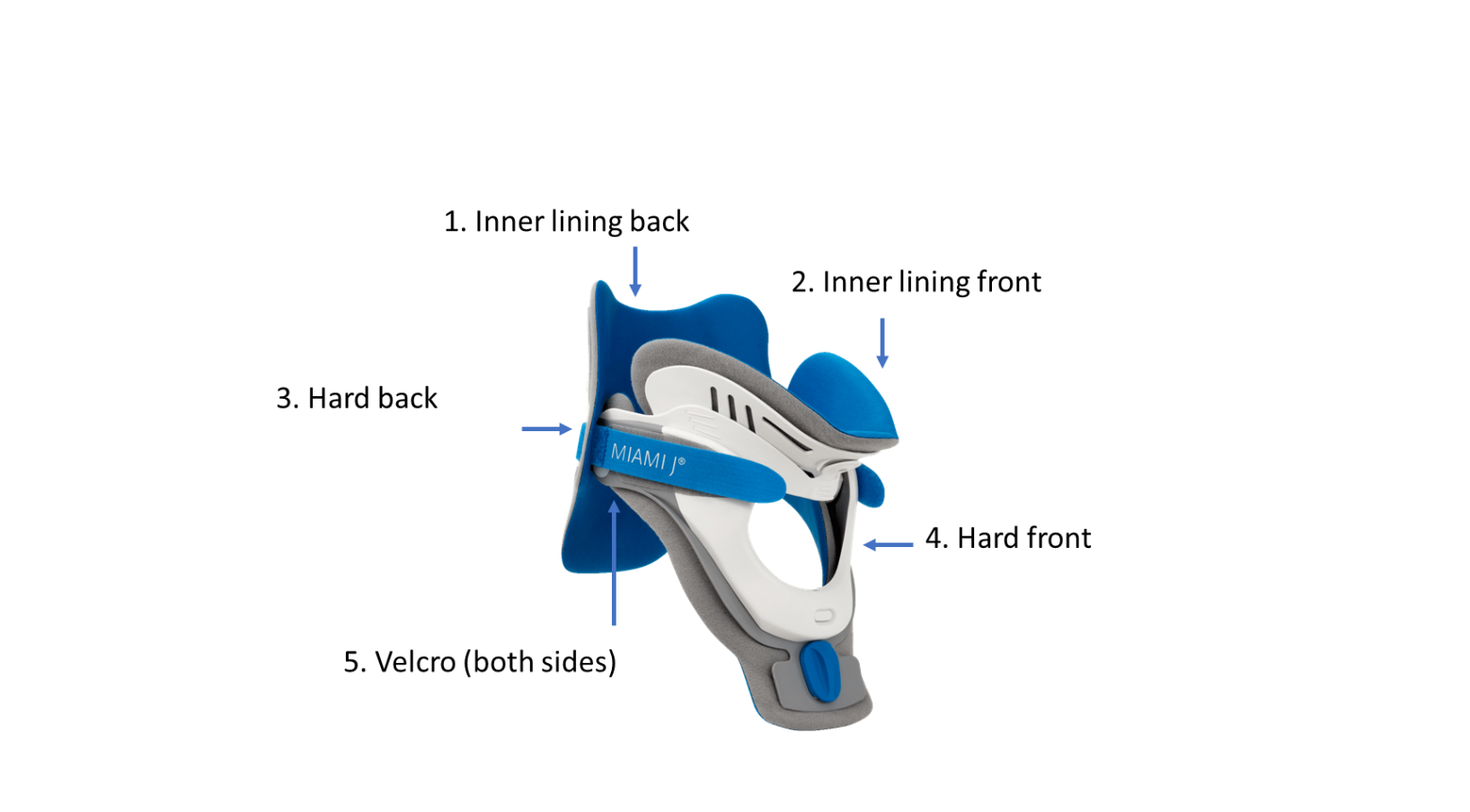In this pamphlet you can read important information about the Miami J® neck collar, what the treatment with the neck collar entails, as well as details regarding the hygiene of the neck collar.
What is a Miami J® neck collar?
A Miami J® neck collar is a hard neck collar that aims to minimize the movement of the cervical vertebrae, in order to improve healing of the bone and surrounding structures. The neck collar must be worn 24 hours a day. The neck collar consists of 2 parts: a front and back with a soft, removable inner lining. The (longer) front of the neck collar is supported on the chest bone; the back against the neck and the back of the head. The neck collar is fastened with Velcro (see image 1).

Image 1. Miami J® neck collar
You have been prescribed a Miami J® neck collar because you:
- have one or more unstable fracture(s) of the cervical vertebra(e), that do not require surgery;
- have injury to the ligaments and/or other surrounding tissue (facet joints, muscles) around the vertebrae of the neck;
- recently underwent neck surgery.
What does the treatment involve?
Depending on the reason why you are wearing the neck collar, the minimum treatment duration varies from 6 to 12 weeks. Especially in the beginning, wearing the neck collar can be experienced as uncomfortable. It will limit you in your mobility and daily activities. However, the healing process is promoted by wearing the neck collar as prescribed (24 hours a day). If you don’t wear the neck collar as prescribed, there is a chance that the cervical vertebrae will slip, with possible risk of (permanent) neurological damage to the spinal cord and/or nerve roots. This may cause pain, tingling and/or a reduced feeling of the neck, shoulders, arms and/or hands. In this situation, it may even be necessary to undergo surgery.
The course of the treatment
Depending on your physical condition, and whether you have any additional injuries, the doctor will determine if you can go home from the emergency room, or whether it is necessary for you to be admitted. If you need to be admitted, you will be transferred to the intensive care unit or the neurosurgery, neurology or traumatology ward.
Discharge
When your physical conditions has improved enough, you can go home. You will receive an appointment for the first outpatient clinic visit, which will take place about 2-3 weeks after discharge, with the nurse specialist of the neurosurgery department. You will receive one additional set of inner linings, so you can replace the inner linings regularly. If you have not received this set during your admission, you will receive it during your first outpatient clinic visit. The procedure to replace the inner linings is described further on in this pamphlet.
Outpatient clinic
After discharge from hospital, you will visit the outpatient clinic regularly for a check-up, where imaging of the neck will be performed (X-rays and CT scans). Depending on the results of these imaging, the type of injury/fracture that you have, and your physical condition, the duration of the treatment with de neck collar will be determined. If the imaging shows that the position of the cervical vertebrae has deteriorated, or if you develop new or progressive neurological symptoms (such as pain, tingling or loss of strength), surgery can still be opted for.
The nurse specialist will determine, in consultation with the radiologist and neurosurgeon, when the collar may be removed, which is usually after 6 to 12 weeks. This is often experienced as a relief, but it is important to realize that your neck muscles did not function normally during the time you wore the neck collar. The muscles of the neck have to get used to 'bearing' the weight of the head again. Therefore, it is advised to slowly reduce the time you wear the neck collar in the course of about 1 to 2 weeks. This will give your neck muscles time to get adapt to working without a neck collar. This time schedule will be discussed with you in detail.
Hygiene
Personal hygiene
During the period that you have to wear the neck collar, personal hygiene will become more difficult than you are used to. It is advisable to do this when there is a second person present, so that he or she can help you with removing of the neck collar, washing your neck and changing the inner lining. During this activity it is extremely important that you keep your head still and keep looking straight ahead. Your head should not move up or down and don’t turn sideways ('no shaking of the head').
Instructions
- Sit straight on a chair (preferably without a headrest);
- Support the front of the neck collar with your hand, loosen both blue Velcro straps on the front of the neck collar and remove the back of the neck collar. The neck can now be washed and dried, and the inner lining of the back can be changed. The inner lining is fastened with Velcro and it is in the right position when the shiny part is towards the skin;
- Place the back of the neck collar against the neck and support it with your hand. Make sure that the arrows on the back of the neck collar point upwards. Now the front part of the neck collar can be removed and the neck can now be washed and dried (and shaved if necessary), and the inner lining of the front can be changed;
- Place the front of the neck collar against your neck and fasten the collar with the Velcro. The sides of the back of the neck collar should slide over the sides of the front of the neck collar (see image 1).
- Make sure the neck collar is straight and tight enough.
- Take good care that the inner lining is not doubled up anywhere, and that it fully covers the white part of the neck collar everywhere.
- If you prefer to have the inner lining replaced by the nurse specialist in the outpatient clinic, you can bring the clean inner lining to your next appointment. Unfortunately, there is no time for your personal hygiene at that time.
Shower
It is possible to take a shower with the neck collar on. After showering, you can dry the neck collar with a towel and change the inner lining for a dry one. Follow the steps exactly as described above.
Cleaning of the neck collar
In principle, the inner lining of the neck collar should be cleaned daily or every other day, depending on the degree of contamination. It is advised to combine this with your personal hygiene.
- Remove the contaminated inner lining from the white plastic parts of the neck collar. These are fastened with Velcro;
- Clean the inner lining by hand in warm water with a small amount of detergent;
- Rinse the inner liner thoroughly with water. Remaining soap residues can cause skin irritation;
- Wring out the inner lining as much as possible;
- Let the inner lining, lying flat, dry in the air;
- The white plastic parts of the neck collar can be also cleaned (if required with a mild soap).
What are you allowed to do in daily life?
Activities
What you can do depends on your psychological and physical condition. It is good to know your limits. Your body will indicate when your activities are too much. Performing sports or heavy labor is discouraged. When your neck hurts, it is wise to take a rest. It is also important that you keep your balance in everything you do. Think of this when choosing shoes, changing socks, and carrying out certain activities. Take a seat first.
Sleeping
Your sleep pattern can change by wearing the neck collar. Your night's sleep will be interrupted more often than before, because it is more difficult to find a good sleeping position. Sleeping on your tummy is not recommended.
Transport
Because you cannot move your head to the left or right, you are not allowed to drive a car, motor vehicles or a bicycle yourself. Sitting next to the driver as a passenger is no problem.
You must contact us when:
- You feel increasing pain in the neck, shoulders, arms, hands and/or fingers;
- You feel tingling in the neck, shoulders, arms, hands and/or fingers;
- You feel a reduction of muscle strength in the neck, shoulders, arms, hands and/or fingers;
- You are worried for any reason.
Contact information
During the day:
Outpatient clinic Neurosurgery: 020 56 625 00
Out of office hours:
Nursing department H6 Neuro-centre: 020 56 640 63
If necessary, the neurosurgical doctor on call: 020 56 633 33
Do you have any questions?
If you have any questions, you can contact your attending doctor or nurse specialist through the Outpatient clinic Neurosurgery, telephone number 020 56 625 00.

